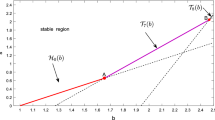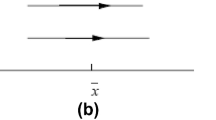Abstract
In the present paper, a spatially discretized diffusive Brusselator model with zero-flux boundary conditions is considered. Firstly, the global existence and uniqueness of the positive solution are proved. Then the local stability of the unique spatially homogeneous steady state is considered by analyzing the relevant eigenvalue problem with the aid of decoupling method. Hence, the occurrence conditions of Turing bifurcation and Hopf bifurcation for the model at this steady state are obtained. Meanwhile, the comparative simulations on the stability regions of the steady state between the spatially discretized diffusive Brusselator model and its counterpart in continuous space are given. Furthermore, the approximate expressions of the bifurcating periodic solutions are derived according to Hopf bifurcation theorem. The bifurcating spatially nonhomogeneous periodic solutions show the formation of a special kind of periodic structures for this model. Finally, numerical simulations are given to demonstrate the theoretical results.










Similar content being viewed by others
Data availability
Not applicable. No datasets were generated or analyzed during the study.
References
Lefever, R.: The rehabilitation of irreversible processes and dissipative structures’ 50th anniversary. Phil. Trans. R. Soc. A. 376, 20170365-1-15 (2018)
Kostet, B., Tlidi, M., Tabbert, F., Frohoff-Hülsmann, T., Gurevich, S.V., Averlant, E., Rojas, R., Sonnino, G., Panajotov, K.: Stationary localized structures and the effect of the delayed feedback in the Brusselator model. Phil. Trans. R. Soc. A. 376, 20170385-1-18 (2018)
Tlidi, M. , Gandica, Y., Sonnino, G., Averlant, E., Panajotov,K.: Self-replicating spots in the Brusselator model and extreme events in the one-dimensional case with delay. Entropy, 64, e18030064-1-10 (2016)
Epstein, I.R., Pojman, J.A., Steinbock, O.: Introduction: Self-organization in nonequilibrium chemical systems. Chaos, 16, 037101-1-7 (2006)
Prigogine, I., Lefever, R.: Symmetry breaking instabilities in dissipative systems II. J. Chem. Phys. 48, 1695–1700 (1968)
You, Y.C., Zhou, S.F.: Global dissipative dynamics of the extended Brusselator system. Nonlinear Anal. RWA. 13, 2767–2789 (2012)
Anguelov, R., Stoltz, S.M.: Stationary and oscillatory patterns in a coupled Brusselator model. Math. Comput. Simulat. 133, 39–46 (2017)
Erneux, T., Reiss, E.L.: Brusselator isolas. SIAM J. Appl. Math. 43(6), 1240–1246 (1983)
Brown, K.J., Davidson, F.A.: Global bifurcation in the Brusselator system. Nonlinear Anal. TMA. 24(12), 1713–1725 (1995)
Peng, R., Wang, M.X.: Pattern formation in the Brusselator system. J. Math. Anal. Appl. 309, 151–166 (2005)
Peng, R., Yang, M.: On steady-state solutions of the Brusselator-type system. Nonlinear Anal. RWA. 71, 1389–1394 (2009)
Zuo, W.J., Wei, J.J.: Multiple bifurcations and spatiotemporal patterns for a coupled two-cell Brusselator model. Dyn. Partial Differ. Eqs. 8(4), 363–384 (2011)
Jia, Y.F., Li, Y., Wu, J.H.: Coexistence of activator and inhibitor for Brusselator diffusion system in chemical or biochemical reactions. Appl. Math. Lett. 53, 33–38 (2016)
Ma, M.J., Hu, J.J.: Bifurcation and stability analysis of steady states to a Brusselator model. Appl. Math. Comput. 236, 580–592 (2014)
Ghergu, M.: Non-constant steady-state solutions for Brusselator type systems. Nonlinearity 21, 2331–2345 (2008)
Guo, B.L., Han, Y.Q.: Attractor and spatial chaos for the Brusselator in \(\mathbb{R} ^N\). Nonlinear Anal. 70, 3917–3931 (2009)
You, Y.C.: Global dynamics of the Brusselator equations. Dyn. Partial Differ. Eqs. 4(2), 167–196 (2007)
Ghergu, M., R\(\check{a}\)dulescu, V.: Turing patterns in general reaction-diffusion systems of Brusselator type. Comm. Contemp. Math. 12(4), 661-679 (2010)
Lv, Y.H., Liu, Z.H.: Turing-Hopf bifurcation analysis and normal form of a diffusive Brusselator model with gene expression time delay. Chaos Soliton Fract. 152, 111478 (2021)
Li, Y.: Hopf bifurcations in general systems of Brusselator type. Nonlinear Anal. RWA 28, 32–47 (2016)
Li, B., Wang, M.X.: Diffusion-driven instability and Hopf bifurcation in Brusselator system. Appl. Math. Mech. Engl. Ed. 29(6), 825–832 (2008)
Guo, G.H., Wu, J.H., Ren, X.H.: Hopf bifurcation in general Brusselator system with diffusion. Appl. Math. Mech. Engl. Ed. 32(9), 1177–1186 (2011)
Guo, G.H., Li, B.F.: Turing instability and Hopf bifurcation for the general Brusselator system. Adv. Mat. Res. 255–260, 2126–2130 (2011)
Nicolis, G.: Introduction to Nonlinear Science. Cambridge University Press, Cambridge (1995)
Hassard, B.D., Kazarinoff, N.D., Wan, Y.H.: Theory and Applications of Hopf Bifurcation. Cambridge University Press, Cambridge (1981)
Tzou, J.C., Ma, Y.P., Bayliss, A., Matkowsky, B.J., Volpert, V.A.: Homoclinic snaking near a codimension-two Turing-Hopf bifurcation point in the Brusselator model. Phys. Rev. E 87, 022908 (2013)
Yan, X.P., Zhang, P., Zhang, C.H.: Turing instability and spatially homogeneous Hopf bifurcation in a diffusive Brusselator system. Nonlinear Anal. Model. 25(4), 638–657 (2020)
Huang, J.H., Lu, G.: Global attractor and its dimension of discretized FitzHugh-Nagumo equations. Acta Math. Sci. 21A(3), 296–302 (2001)
Jiang, M.R., Guo, B.L.: Attractors for discretized Ginzburg-Landau-BBM equations. J. Comput. Math. 19(2), 195–204 (2001)
Chua, L.O., Yang, L.: Cellular neural networks: theory. IEEE Trans. Circuits Syst. 35(1), 1257–1272 (1988)
Goras, L., Chua, L.O., Leenaerts, D.M.W.: Turing patterns in CNNs. I. Once over lightly. IEEE Trans. Circuits Syst. I:Fundam. Theory Appl. 42(10), 602–611 (1995)
Goras, L., Chua, L.O.: Turing patterns in CNNs. II. Equations and behaviors. IEEE Trans. Circuits Syst. I: Fundam. Theory Appl. 42(10), 612–626 (1995)
Goras, L., Chua, L.O., Pivka, L.: Turing patterns in CNNs. III. Computer simulation results. IEEE Trans. Circuits Syst. I: Fundam. Theory Appl. 42(10), 627–637 (1995)
Hethcote, H.W.: Qualitative analyses of communicable disease models. Math. Biosci. 28(3–4), 335–356 (1976)
Wang, W.D., Zhao, X.Q.: An epidemic system in a patchy environment. Math. Biosci. 190(1), 97–112 (2004)
Gao, D.Z.: How does dispersal affect the infection size. SIAM J. Appl. Math. 80(5), 2144–2169 (2020)
Turing, A.M.: The chemical basis of morphogenesis. Philos. Trans. R. Soc. Lond. Ser. B 237, 37–72 (1952)
Othmer, H.G., Scriven, L.E.: Instability and dynamic pattern in cellular networks. J. Theor. Biol. 32, 507–537 (1971)
Li, Z.X., Xia, C.Y.: Turing instability and Hopf bifurcation in cellular neural networks. Int. J. Bifur. Chaos 31, 2150143-1-17 (2021)
Golubitsky M., Stewart, I. N.: Hopf bifurcation with dihedral group symmetry: coupled nonlinear oscillators. In: Golubitsky, M., Guckenheimer, J. (eds.) Multiparameter Bifurcation Series, pp. 131–173. Contemporary Mathematics 46, Amer Math. Soc., Providence (1986)
Ni, W.M., Tang, M.X.: Turing patterns in the Lengyel–Epstein system for the CIMA reaction. Trans. Amer. Math. Soc. 357(10), 3953–3969 (2005)
Peng, R., Yi, F.Q., Zhao, X.Q.: Spatiotemporal patterns in a reaction-diffusion system with the Degn–Harrison reaction scheme. J. Differ. Equ. 254(6), 2465–2498 (2013)
Li, S.B., Wu, J.H., Dong, Y.Y.: Turing patterns in a reaction-diffusion model with the Degn–Harrison reaction scheme. J. Differ. Equ. 259(5), 1990–2029 (2015)
Yi, F.Q., Wei, J.J., Shi, J.P.: Bifurcation and spatiotemporal patterns in a homogeneous diffusive predator-prey system. J. Differ. Equ. 246(5), 1944–1977 (2009)
Jiang, J., Song, Y.L.: Bifurcation analysis and spatiotemporal patterns of nonlinear oscillations in a ring lattice of identical neurons with delayed coupling. Abstr. Appl. Anal. 2014, 368652 (2014)
Song, Y.L., Yang, R., Sun, G.Q.: Pattern dynamics in a Gierer–Meinhardt model with a saturating term. Appl. Math. Model. 46, 476–491 (2017)
Shi, Q.Y., Shi, J.P., Song, Y.L.: Hopf bifurcation in a reaction-diffusion equation with distributed delay and Dirichlet boundary condition. J. Differ. Equ. 263(10), 6537–6575 (2017)
Song, Y.L., Jiang, H.P., Liu, Q.X., Yuan, Y.: Spatiotemporal dynamics of the diffusive Mussel-Algae model near Turing-Hopf bifurcation. SIAM J. Appl. Dyn. Syst. 16(4), 2030–2062 (2017)
Yan, X.P., Chen, J.Y., Zhang, C.H.: Dynamics analysis of a chemical reaction-diffusion system subject to Degn–Harrison reaction scheme. Nonlinear Anal. RWA. 48, 161–181 (2019)
Zhou, J.: Bifurcation analysis of a diffusive predator-prey model with ratio-dependent Holling type III functional response. Nonlinear Dyn. 81, 1535–1552 (2015)
Hu, G.P., Feng, Z.S: Turing instability and pattern formation in a strongly coupled diffusive predator-prey system, Int. J. Bifur. Chaos 30, 2030020-1-15 (2020)
Nakao, H., Mikhailov, A.S.: Turing patterns in network-organized activator-inhibitor systems. Nature phys. 6, 544–550 (2010)
Petit, J., Asllani, M., Fanelli, D., Lauwens, B., Carletti, T.: Pattern formation in a two-component reaction-diffusion system with delayed processes on a network. Phys. A 462, 230–249 (2016)
Liu, C., Chang, L.L., Huang, Y., Wang, Z.: Turing patterns in a predator–prey model on complex networks. Nonlinear Dyn. 99, 3313–3322 (2020)
Zheng, Q.Q., Shen, J.W., Xu, Y.: Turing instability in the reaction-diffusion network. Phys. Rev. E. 102, 062215-1-9 (2020)
Gou, W., Jin, Z.: Understanding the epidemiological patterns in spatial networks. Nonlinear Dyn. 106, 1059–1082 (2021)
Shi, Y.L., Liu, Z.H., Tian, C.R.: Hopf bifurcation in an activator-inhibitor system with network. Appl. Math. Lett. 98, 22–28 (2019)
Ji, Y.S., Shen, J.W.: Turing instability of Brusselator in the reaction-diffusion network. Complexity. 2020, 1572743-1-12 (2020)
Yang, M.X., Guo, S.J., Chen, Y.R., Dai, Q.L., Li, H.H., Yang, J.Z.: Chimera states with coherent domains owning different frequencies in a ring of nonlocally coupled Brusselators. Nonlinear Dyn. 104, 2843–2852 (2021)
Acknowledgements
The authors are grateful to the reviewer’s valuable comments, which led to the improvement of this article.
Funding
This work is partially supported by National Natural Science Foundation of China (Nos.11971143,11601384,12071074) and Tianjin Municipal Education Commission Research Project (No.2018KJ147).
Author information
Authors and Affiliations
Corresponding author
Ethics declarations
Conflicts of interest
The authors declare that they have no conflict of interest.
Additional information
Publisher's Note
Springer Nature remains neutral with regard to jurisdictional claims in published maps and institutional affiliations.
Rights and permissions
Springer Nature or its licensor holds exclusive rights to this article under a publishing agreement with the author(s) or other rightsholder(s); author self-archiving of the accepted manuscript version of this article is solely governed by the terms of such publishing agreement and applicable law.
About this article
Cite this article
Li, Z., Song, Y. & Wu, C. Turing instability and Hopf bifurcation of a spatially discretized diffusive Brusselator model with zero-flux boundary conditions. Nonlinear Dyn 111, 713–731 (2023). https://doi.org/10.1007/s11071-022-07863-z
Received:
Accepted:
Published:
Issue Date:
DOI: https://doi.org/10.1007/s11071-022-07863-z




